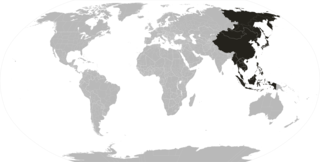
In European terminology, the Far East is the geographical region that includes East and Southeast Asia as well as, to a lesser extent, the Russian Far East. South Asia is sometimes also included for economic and cultural reasons.

Arisaema is a large and diverse genus of the flowering plant family Araceae. The largest concentration of species is in China and Japan, with other species native to other parts of southern Asia as well as eastern and central Africa, Mexico and eastern North America. Asiatic species are often called cobra lilies, while western species are often called jack-in-the-pulpit; both names refer to the distinctive appearance of the flower, which consists of an erect central spadix rising from a spathe.

Asia-Pacific (APAC) is the part of the world near the western Pacific Ocean. The Asia-Pacific region varies in area depending on the context, but it often includes countries in East Asia, Southeast Asia, and Oceania that border the Pacific Ocean. Afghanistan, the Indian subcontinent, Mongolia, Myanmar, and the Russian Far East are generally included in a wider Asia-Pacific region.

Endoclita is a genus of moths of the family Hepialidae. There are 60 described species found in eastern and southeast Asia and the Indian subcontinent.

This is a gallery of international and national flags used in Asia.
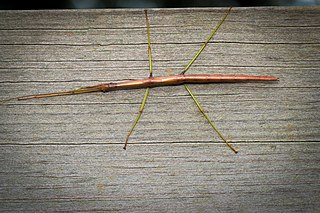
The common walkingstick or northern walkingstick is a species of phasmid or stick insect found across North America. The average length of this species is 75mm (3 in) for males and 95mm (3.7 in) for females.

Neottia is a genus of orchids. The genus now includes the former genus Listera, commonly known as twayblades referring to the single pair of opposite leaves at the base of the flowering stem. The genus is native to temperate, subarctic and arctic regions across most of Europe, northern Asia, and North America, with a few species extending into subtropical regions in the Mediterranean, Indochina, the southeastern United States, etc.
Eastern Orthodox Metropolitanate of Hong Kong and Southeast Asia is an Eastern Orthodox diocese of the Ecumenical Patriarchate of Constantinople. It is centred in Hong Kong and has jurisdiction over Eastern Orthodox Christians in Southeast Asia. It was established in November 1996 by the decision of the Holy Great Synod of Constantinople.
Cerberolebeda is a monotypic moth genus in the family Lasiocampidae described by Vadim V. Zolotuhin in 1995. Its single species, Cerberolebeda styx, described by the same author in the same year, is found in eastern India, Myanmar, northern Thailand, northern Laos, northern Vietnam and Hainan, China.
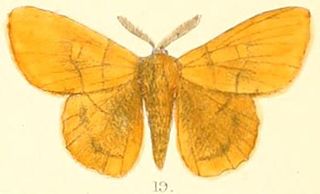
Crinocraspeda is a monotypic moth genus in the family Lasiocampidae erected by George Hampson in 1893. Its only species, Crinocraspeda torrida, was described by Frederic Moore in 1879.

Lasiocampa is a genus of moths in the family Lasiocampidae. The genus was described by Franz von Paula Schrank in 1802.

Paralebeda is a genus of moths in the family Lasiocampidae. The genus was erected by Per Olof Christopher Aurivillius in 1894.
Syrastrenopsis is a genus of moths in the family Lasiocampidae. The genus was erected by Karl Grünberg in 1914.
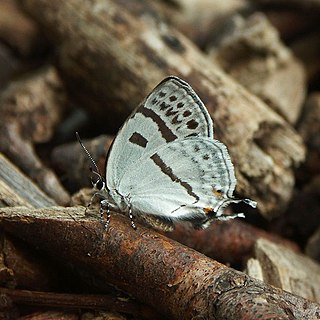
Antigius attilia is a butterfly of the family Lycaenidae. It is widespread from Japan, the Korean Peninsula, the Russian Far East throughout northern, central and western China to Taiwan.

Ambulyx sericeipennis, the common gliding hawkmoth, is a species of moth of the family Sphingidae first described by Arthur Gardiner Butler in 1875. It is found from northern Pakistan and northern India eastwards across Nepal, Sikkim, Bhutan, Myanmar, Thailand, Laos, Cambodia and Vietnam to central and southern China and Taiwan.

Paradoxopla sinuata is a moth of the family Lasiocampidae. It is found from India to Taiwan.

Paralebeda plagifera is a moth of the family Lasiocampidae. It is found in northern and central India, Nepal, southern and south-eastern China, northern Thailand, northern Vietnam and Taiwan.
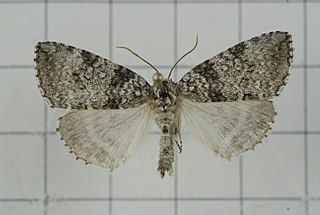
Parapsestis argenteopicta is a moth in the family Drepanidae. It was described by Oberthür in 1879. It is found in the Russian Far East, Korea, Japan, Taiwan, western, north-eastern, northern and central China and Nepal. The habitat consists of various types of mixed forests and oak woods.














